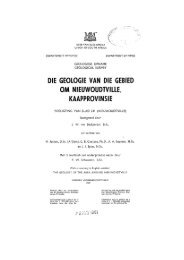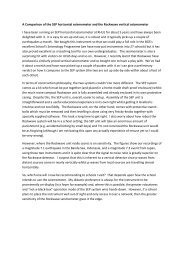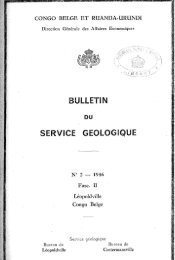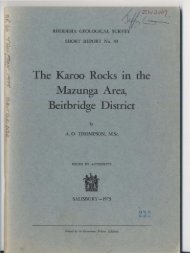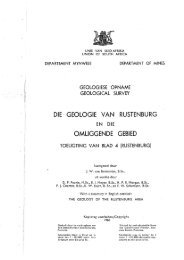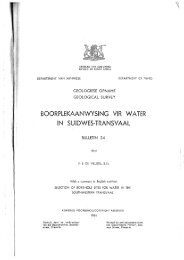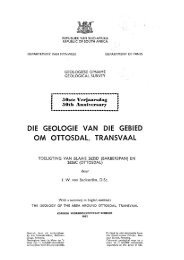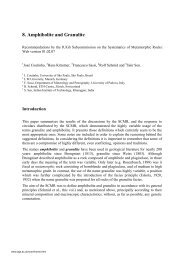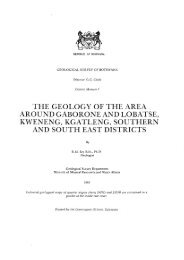Bibliography - British Geological Survey
Bibliography - British Geological Survey
Bibliography - British Geological Survey
Create successful ePaper yourself
Turn your PDF publications into a flip-book with our unique Google optimized e-Paper software.
Woodward, A. S. 1916. Obituary: Charles Dawson, F.S.A., F.G.S. <strong>Geological</strong> Magazine, dec. 6, 3 (10),<br />
477–479. (Charles Dawson was born at Fulkeith Hall, Lancashire, 11 July 1864, and died 10 Aug 1916. ‘He<br />
had a restless mind, ever alert to note anything unusual; and he was never satisfied until he had exhausted all<br />
means to solve and understand any problem which presented itself. He was a delightful colleague in scientific<br />
research, always cheerful, hopeful, and overflowing with enthusiasm.’)<br />
Woodward, A. S. 1917a. Early man. <strong>Geological</strong> Magazine, dec. 6, 4 (1), 1‒4. (A critique of Henry Fairfield<br />
Osborn’s Men of the Old Stone Age, 1915, 2nd edition 1916, and Hugo Obermaier’s El Hombre Fósil, 1916.<br />
Woodward takes issue with Osborn’s interpretation of Eoanthropus. He expects soon to announce a discovery<br />
made by Dawson shortly before his death, confirming the interpretation that he and Dawson published in<br />
1912 (Woodward 1917b). He admits that the associated mammalian fauna, some of which derives from an<br />
older stratum, does not permit Eoanthropus to be dated with exactness. In 1913 he was able to visit Eugene<br />
Dubois in Holland in order to examine all the original specimens of Pithecanthropus erectus from Java, and<br />
was impressed by its resemblance to a gibbon, a view then being entertained by its finder. Osborn considers<br />
Pithecanthropus to be a lowly type of man, whereas Obermaier treats it as a gigantic ape. Likewise, in 1912<br />
Woodward went to Heidelberg in order to examine the lower jaw of Homo heidelbergensis and the associated<br />
mammalian remains. ‘As all palæontologists agree, this mammalian fauna must date back to a very early part<br />
of the Pleistocene period.’ In 1914 a well-fossilised human skull was found in a river deposit at Talgai in the<br />
Darling Downs, Queensland. ‘Although in nearly every respect the skull of a typical Australian aborigine,<br />
this fossil agrees with Eoanthropus from Piltdown in having the relatively large canine teeth interlocking as<br />
in the apes, and it is the only known skull of Homo exhibiting this arrangement.’)<br />
Woodward, A. S. 1917b. Fourth note on the Piltdown gravel, with evidence of a second skull of Eoanthropus<br />
dawsoni. Abstracts of the Proceedings of the <strong>Geological</strong> Society of London, no. 1003 (9 Mar), 50–53. (Abstract<br />
of paper and full record of discussion, with contributions from W. P. Pycraft, Prof. A. Keith, Sir Ray Lankester<br />
and W. Dale; includes details of specimens exhibited. See Woodward 1918 for full text of paper and reprint<br />
of discussion.)<br />
Woodward, A. S. 1918a. Fourth note on the Piltdown gravel, with evidence of a second skull of Eoanthropus<br />
dawsoni. Quarterly Journal of the <strong>Geological</strong> Society of London, for 1917, 73 (1) 1–10 (with discuss), plate<br />
I (folded). (Read 28 Feb, 1917. Further extensive excavations at Piltdown during the summer of 1916 failed<br />
to yield anything of interest beyond a battered nodule of black flint, here supposed to be a hammer-stone.<br />
During the winter of 1914–15, Dawson had searched a large field about 2 miles from the Piltdown pit and<br />
had succeeded in finding two well-fossilised pieces of human skull and a molar tooth belonging to a second<br />
individual of Eoanthropus dawsoni. An appendix is included by G. Elliot Smith ‘On the form of the frontal<br />
pole of an endocranial cast of Eoanthropus dawsoni’, pp. 7‒8. In the discussion which followed the reading of<br />
this paper, W. P. Pycraft exhibited the right half of a chimpanzee mandible sent to him by Gerrit S. Miller, in<br />
which the molars were worn flat like those of the Piltdown jaw, but Pycraft regarded this as an abnormality.<br />
Sir Ray Lankester suggested the possibility, ‘although highly improbable’, that the new molar and piece of<br />
frontal bone could belong to the first Piltdown find, though not the occipital fragment, which was already<br />
present in the latter. Little did he realise how prophetic this suggestion would prove to be!)<br />
Woodward, A. S. 1918b. A guide to the fossil remains of man in the Department of Geology and<br />
Palæontology in the <strong>British</strong> Museum (Natural History). 2nd ed. London: Trustees of the <strong>British</strong> Museum,<br />
32 pp. 4 plates.<br />
Woodward, A. S. 1919. The Antiquity of Man. Nature, 104, 212–213, 335. (Discussion of Eoanthropus<br />
and Pithecanthropus)<br />
Woodward, A. S. 1922. A guide to the fossil remains of Man in the Department of Geology and Palaeontology<br />
in the <strong>British</strong> Museum (Natural History). 3rd ed. London: Trustees of the <strong>British</strong> Museum, 34 pp, 6 plates.<br />
(Piltdown man, pp. 8–25, plates I–IV)<br />
Woodward, A. S. 1923. The first man on earth. Weekly Dispatch, 4 Mar.<br />
Woodward, A. S. 1926. The Palæolithic drawing of a horse from Sherborne, Dorset. Nature, 117 (16 Jan),<br />
86. (Expresses surprise at W. J. Sollas’s claim in the 3rd edition of his Ancient Hunters, p. 536, that the<br />
drawing of the head of a horse on bone from Sherborne, which Woodward described in 1914, is a forgery<br />
perpetrated by some schoolboys. Woodward quotes confirmation from one of the surviving finders as to its<br />
genuineness. See reply by Sollas 1926)



